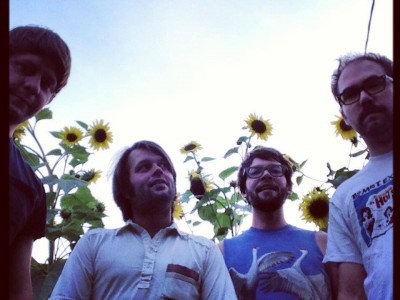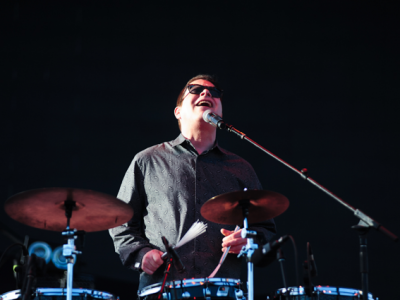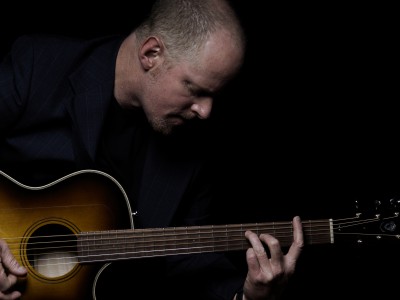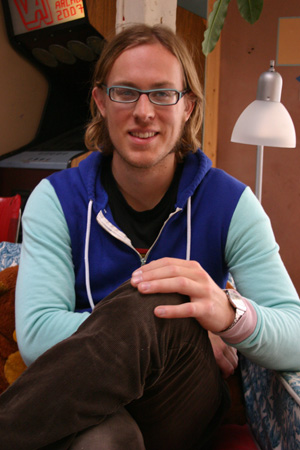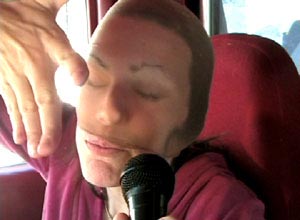Profile
The Curious Journey of Midwest Beat
Formed in Madison, now based in Milwaukee, the band specializes in what its members have dubbed “Angry Bubblegum” music.
Aug 5th, 2014 by Andy TurnerThe Primal Art of Brian Hibbard
The Green Bay native is hoping to shake up the Milwaukee art scene.
Jul 23rd, 2014 by Jerrod JohnsonThe Whimsical Journey of Marina Lee
Artist who created Snails Crossing loves working with neighborhoods and neighbors.
Jul 22nd, 2014 by Judith Ann MoriartyHow James Steeno Created His Own Gallery
The watercolor artist displays at art fairs but also has a gallery on Vliet Street.
Jul 16th, 2014 by Lisa BonvissutoAfter the Femmes Are Over
Victor DeLorenzo is glad to be gone from the Violent Femmes, building a different life with two newer bands.
Jul 9th, 2014 by Garrick JanneneThe Dreams of Al Vento
West Allis native is making it as Hollywood actor, but it hasn’t been easy.
Jul 1st, 2014 by Brett KihlmireIs She Western or Eastern?
Korean-raised artist Kyoung Ae Cho draws on nature to create quietly elegant work, now at Lynden Sculpture Garden.
Jun 13th, 2014 by Richard DavisWilly Porter’s Latest Adventure
How the longtime guitarist and singer-songwriter became the composer for an original children’s play.
May 13th, 2014 by Garrick JannenePat Graham
Music and media pop and move. We are digital and online. Genres slide into each other, constantly bounding forward. That’s why Pat Graham’s new photography book, Silent Pictures, is so important: it’s an anchor to link us to the past. Silent Pictures is his first book, showcasing underground rock at its finest through the past two decades. The collection features bands as diverse as Modest Mouse, Outkast, Elliot Smith, Fugazi, Thievery Corporation, Built To Spill and The Shins, on the road and backstage, in a mode that is raw, dirty, lonely, triumphant, gritty and real. Graham, a Milwaukee native, spoke to VITAL from his London gallery, 96 Gillespie, to discuss Silent Pictures, being on the road with Modest Mouse and future projects. For more information, visit 96gillespie.com or modestmouse.com/photoblog. Define Silent Pictures – what’s its attitude? It’s a photography book, plain and simple. It’s about the images, and hopefully it’ll help expose the road life of bands. We put a lot of thought into the editing, assembling the book like a record to balance quiet and explosive moments. We want to grab attention and get people to stop flipping, to really engage them and get them to inspect interesting photos. With digital photos, we flip to quick. With this book, we want you to stop in your tracks. Describe your evolution as a photographer in the rock world. I was born in Milwaukee and kicked around a bit. I started shooting photos at Café Voltaire in Milwaukee around age 17 and studied photography at UWM. Soon after school, I moved to Washington DC. I had a friend that was in bands out there. That’s what kickstarted my photography at shows. I really got into the scene. Shot a lot of Fugazi in ‘91-‘92. It was around that time I started touring with Modest Mouse. It was me with the three guys and a van. It was bare bones, man. I’d do merch, drive a lot, move gear in and out of shows; shooting the whole time. I still tour with them regularly and post photos on their tour blog. I’ve also had the good fortune to have work printed in major European and U.S. music publications like Rolling Stone. What is your greatest accomplishment as an artist? Doing exhibitions with my wife Melanie Standage – it’s the process of setting them up and seeing things on the wall. Our shows “Past Perfect” or “Wildebeest” were fun to do. The book is a great thing to do and have done but there’s something about showcasing the real prints that always exciting. Also, the Experience Music Project in Seattle purchased a number of my prints for their collection which is a great feeling, too. What’s up in the UK? I founded 96 Gillespie with my wife. It’s a London gallery that features a lot of American artists. It’s a place to start a dialogue between UK and US artists. Describe your evolution as a photographer in the rock music world. Where do […]
Jan 1st, 2008 by Howie GoldklangMarcus Doucette
By Kenya Evans His distinctive voice graces our radio waves as a host on 88Nine, Radio Milwaukee; chalk up his tranquil tone to his meditative practices as a Yoga instructor. By night you may have found him scratching and mixing on the 1’s and 2’s at local hot spots like Jackalope Lounj and Hi Hat Garage – maybe you even caught him opening for Meshell Ndegeocello at Turner Hall in November. A DJ on the local scene for eight years, Marcus Doucette describes his work as “The Mystic Art of Just Being Yourself.” What made you turn to DJing and radio jockeying after school? I [graduated] from Marquette University back in 1998 … I had a really hard time finding a job that was anything other than another paycheck and another week of getting by. At first, DJing was an accident (because I had some records), then it was for fun (because I worked and partied too much anyway), then it was money (because I always needed it). Then something happened; with all of these motivations in mind, I sort of got lucky and landed a gig at 91.7 doing their world music slot, and that was the best opportunity. With the freedom to play music that inspired words, I found that radio was a great place for me to be. Two years at WMSE honed skills that would become a job at 88Nine. The odd thing is this is the job I had never “planned” on getting. What do you think of the Milwaukee arts scene? I have always thought of the scene here as being creative as well as progressive. With MIAD in town and the overall support of events like Gallery Night, Milwaukee has talent as well as some support for that talent. Add a party-like vibe and you have a sense of my sense of the scene in town. What are you working on and who are you working with? Right now I’m doing work with anyone who wants to work with me … currently a musician named Eltron, and another DJ, Dirty Francis, as well as The Architect, Tarik from 88Nine. How do you draw people to your work? Come to my show, I’ll probably ask you; we’ll have a beer and work it out on the dance floor. Talk about your approach to your art. I don’t really consider myself an artist in the traditional sense of the word. If you mean “being involved in creative endeavors,” then maybe, but just barely. I do appreciate it when someone calls me one; I would say that I use a little art in what I do – and that’s stretching the definition a bit. With DJing, I feel my approach is all about the moment. I’ve never been able to plan a set because the impact of the room is very important and the “art” in my DJing is all about how the environment affects my Center … what spins off of that becomes my set, […]
Dec 1st, 2007 by Vital ArchivesJohn Riepenhoff 5 Q
It’s not easy being green, which is why John Riepenhoff, owner and curator of the Green Gallery, established the third-floor Riverwest venue expressly for fresh, emerging artists in 2004. An art school graduate and painter himself, the now-25-year-old could relate. Riepenhoff is interested in social interaction between artists of all media. The space currently hosts a monthly Movie & Masala night for neighborhood filmmakers and sponsors a culturally conscious residency program to align local and global artists, launched by the Institute of Quotidian Arts and Letters this past spring. Between a hectic show opening and a weeklong trip to London’s Frieze Art Fair, John squeezed in our five questions. Keep up with him at thegreengallery.tk. What paved your way from art student to gallery owner/curator? Even as a student, I would question for what and for whom art was made, so exploring the gateway from the artist’s hands to the public arena was a natural progression. Running a low-maintenance space — using a model similar to DIY rock house venues — eased my start, and the playfulness of the artists I exhibited directly elevated the gallery. The more artists and gallerists I met locally and nationally, the more I realized the significance of the Milwaukee art community; that still motivates me to continue the Green Gallery project, and to experiment with methods of showcasing art and encouraging local artists. How do your personal tastes and values guide the Green Gallery cut? The artists who show are ones that surprise me; they are making art that says “things are exciting right now” in a new way, or they are creating interesting situations that don’t yet have a venue but should. They are commenting on the conditions of art and popular culture in a way similar to a writer by critiquing aspects of experience and history, and by offering some alternatives. I like these traits in people, too. I like the meta. What are the highs and lows of your role? I get to meet so many creative and amazing individuals, and get to be a part of their lives. Some of my all-time favorite artists are real people that I helped reach a broader audience! Supporting and empowering artists by stimulating discussion and exposing their ideas to receptive audiences is a real high. Building, sanding, painting, cleaning and fixing the space are all of the lows that make the highs feel better-deserved. What makes Milwaukee a good home for art? In Milwaukee, people can find time for their own projects without having to pay inflated rent that many of the (other) art centers around the country indoctrinate. The art community here is small enough that one can find help for his or her projects in friends and acquaintances, as well as find other projects that might be a perfect showcase of her or his talent. I like to think that we Milwaukeeans can commit to our own personal voices without being distracted by the pettiness of mainstream […]
Nov 1st, 2007 by Amber HerzogInternet killed the video star
Kimberly Miller could be seen as a backward artist in a digital world where YouTube, Metacafe, and Google are the standard mediums of delivery for video art. But due to the omniscient control of the internet viewer, a piece of experimental art or an installation viewed online is kind of safe. It doesn’t help that some of Miller’s pieces incorporate a live element, requiring her to be present. But what is conveyed is so much stronger in person than when someone is home alone, crouched in front of a monitor. While it’s not easy to describe or interpret her work, the viewer always feels something, however ineffable. More questions are raised than answered. If you were having a conversation with Miller she might say “It’s like, you know?” Then you say, “Yeah. It’s all …you know?” This Friday, October 26, at 7 p.m., Kimberly Miller will present selected works on film at Woodland Pattern, where she is hosted and spotlighted by friend and filmmaker Sarah Buccheri. The presentation of selected works and the reception that follows will give the audience a better chance to ask questions and negotiate with Miller regarding her art – which is exactly what she wishes to encourage with her body of work. VS: Is the presentation Friday reflective of what you’re currently working on, or a collective of past and present work? Kimberly Miller: The screening on Friday will show a selection of my video work from the past few years, including a video I made last week. The work represented will be a section of videos and performances-for-the-camera. There will be a live performative element as well, but a bit of a toned-down one. The emphasis will be on the videos. So on a scale of performance from subtle to Vegas-style flashiness: Sequins and glitter? Maybe. Live doves or flying daggers? Probably no. VS: What is your artistic purpose? KM: In my work I’m trying to … grasp certain things, figure them out. What, if any, role can art play beyond cultural production? Does art have the ability to affect change? Is there such a thing as a radically democratic art experience, and if so, what does it look like? Does action determine the actor, is identity determined by what we do, what we say, some combination thereof? I don’t know the answers to these or any other questions, really, but I’m interested in reframing them again and again and attempting to put out some kind of response to the questions. VS: Why did you choose these mediums to convey them? KM: The forms of video and performance are structured within and around language, and for me this is a place where public and private may intersect. Language is public because it is shared; our conception of language is shaped by its use. Yet each of us must come to an individual understanding of language. Language shapes meaning, and may be a place where viewer and artist meet. I try to establish certain parameters […]
Oct 25th, 2007 by Brian Jacobson
